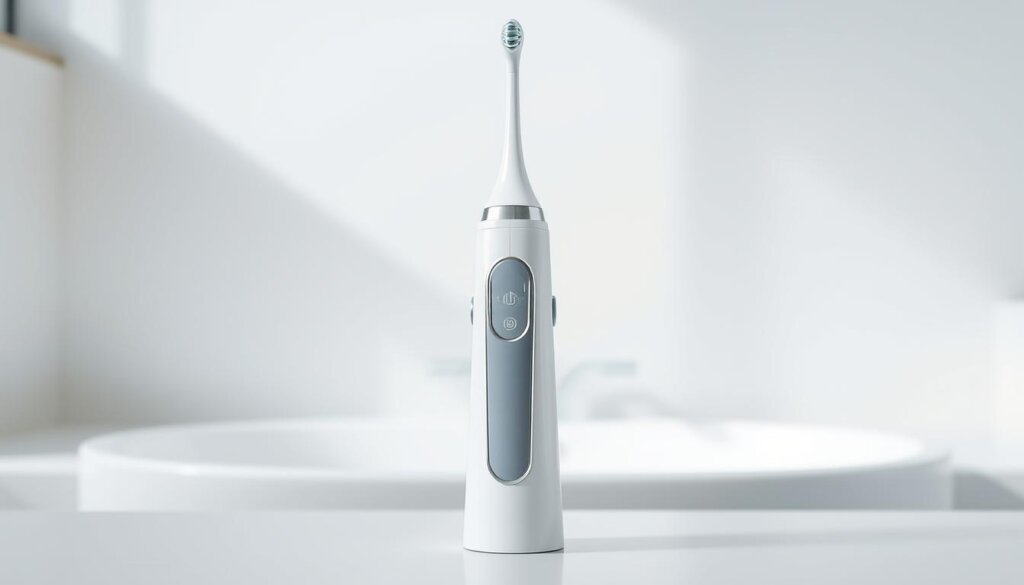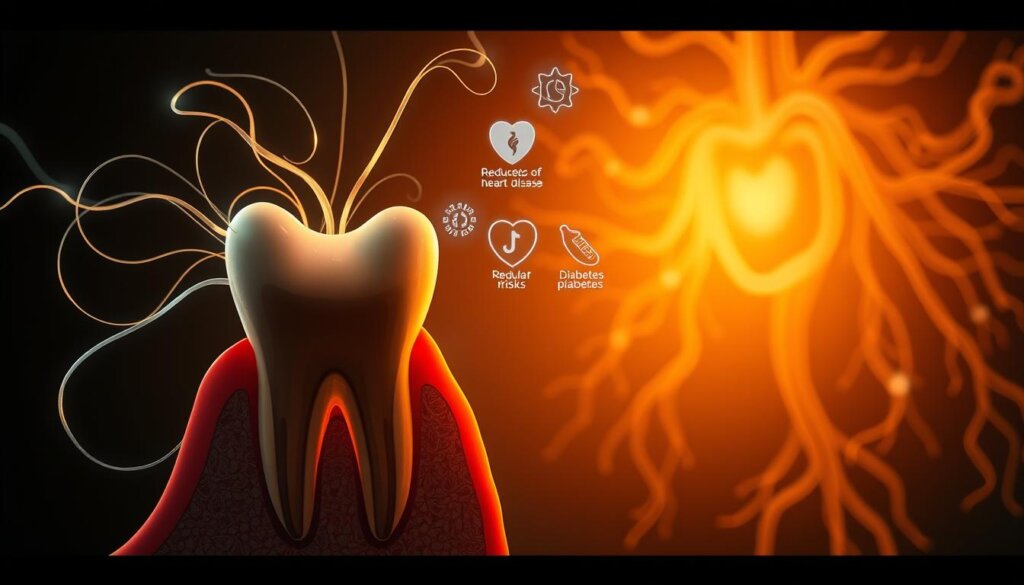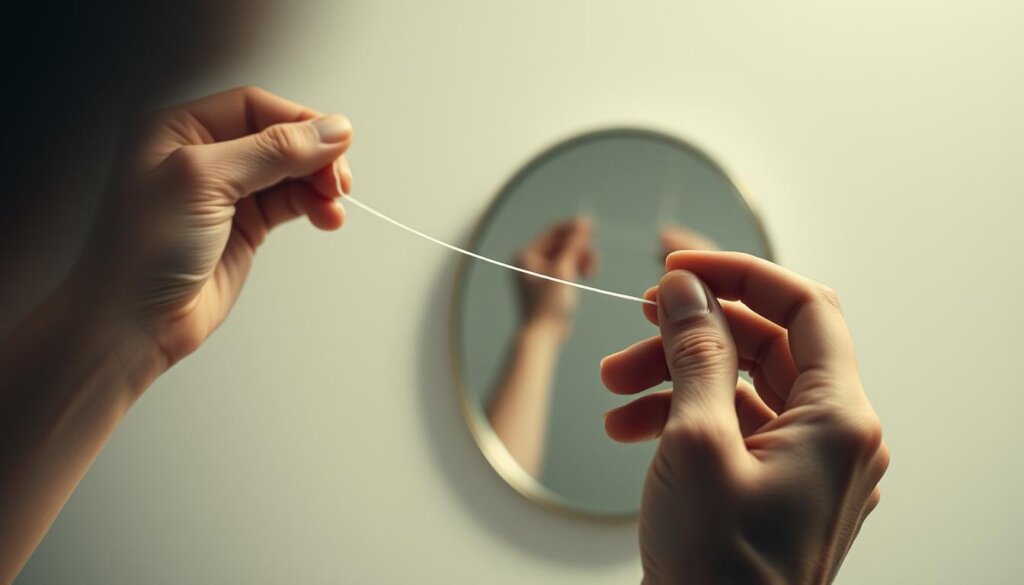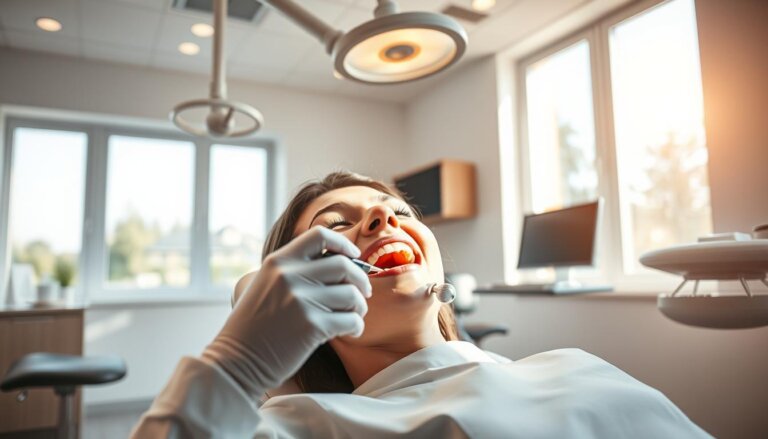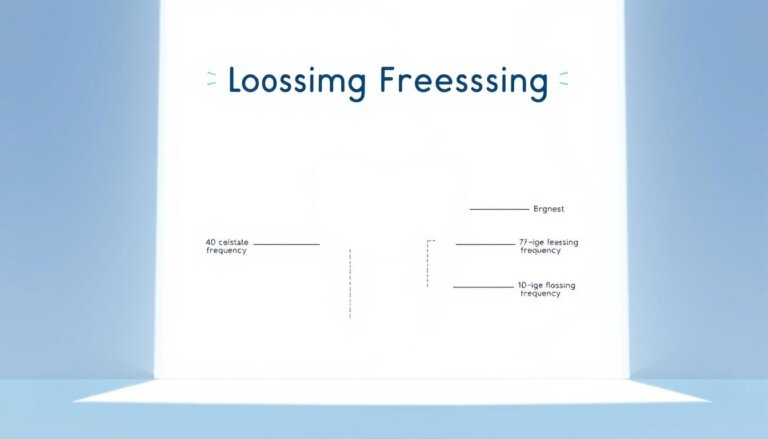Is Flossing Really Necessary? How Often Should I Floss?
About 80% of people in the U.S. say they don’t floss often. This is interesting because dentists really believe flossing is crucial for good mouth health. So, is flossing actually needed? Yes, it is. Flossing does something brushing can’t. It cleans between your teeth and under your gums. These are places where bad stuff like plaque and decay start. Flossing is more than just fresh breath; it stops gum disease and cavities. Dentists agree flossing every day is essential for everyone’s mouth care.
There’s some discussion about how often to floss. But what’s the best frequency for keeping teeth healthy? Experts say you should floss every day, just like brushing. It doesn’t matter if it’s in the morning or night, or before or after brushing. The key is to do it regularly. Flossing first can help remove plaque better and makes your toothpaste work better too.
If flossing is hard for you or you have special dental needs, there are other options. Items like floss picks and dental picks are great alternatives. These tools help kids learn to floss and adults with bigger gaps between their teeth. They ensure everyone can keep their teeth clean, no matter their situation.
Key Takeaways
- Flossing is a critical component in preventing gum disease and cavities, and should be part of daily oral hygiene routines.
- Consistency in dental flossing frequency is crucial for optimal oral health, with most professional guidance recommending daily practice.
- Flexible timing allows individuals to floss at any point during the day, though flossing before brushing may offer additional benefits.
- Floss picks and dental picks are excellent alternatives for those who find traditional flossing challenging, including children and those with specific dental needs.
- Maintaining regular flossing habits contributes significantly to one’s overall dental health and wellbeing.
The Importance of Oral Hygiene
Keeping your mouth healthy is key to your overall health. This includes habits like flossing regularly. Flossing is really important. It helps prevent gum disease, which is common and can cause major issues if not treated.
Understanding Gum Disease
Gum disease includes conditions like gingivitis and periodontitis. It starts with plaque buildup, a bacteria-filled film. If not cleaned, plaque turns into tartar, leading to tooth loss. Flossing regularly gets rid of plaque in hard-to-reach areas, preventing gum disease.
The Role of Flossing in Dental Health
Flossing isn’t just for removing food. It also clears plaque from between teeth and the gumline. This stops the harmful acids that can damage tooth enamel. So, flossing is a must for keeping your mouth clean and preventing decay.
Consequences of Skipping Flossing
Not flossing can quickly harm your dental health. Plaque can form in 24 hours and turn into calculus, which only a dentist can remove. This can lead to gum disease and other serious health issues like heart disease and diabetes.
Flossing is essential in dental care. It stops gum disease and keeps your teeth healthy. By flossing every day, you can fight dental diseases and improve your health.
What is Flossing?
Flossing is crucial for oral health. It uses a thin thread, dental floss, to clean between teeth. It reaches spots your toothbrush can’t, improving interdental cleaning and gum health.
Dental floss varies to suit different needs. Let’s look at the common types:
Types of Dental Floss
| Type | Description | Best For |
|---|---|---|
| Standard Nylon Floss | Made from multiple strands of nylon, available waxed and unwaxed. | General use, especially for tight teeth |
| Dental Tape | Broad and flat structure, smoother flossing experience. | Those with more space between teeth |
| Pre-threaded Flossers | Disposable floss holders, convenient and easy to handle. | Beginners, children, those with dexterity issues |
How Flossing Works
Flossing carefully scrapes off food and plaque where toothbrushes can’t reach. Using the proper flossing technique stops plaque from turning into tartar. Tartar can only be removed by a dentist.
Regular flossing fights gum disease and cavities. It also helps keep your breath fresh and gums healthy.
The Science Behind Flossing
Many studies show that flossing is key in keeping teeth healthy and preventing diseases. It is important to understand this evidence to know why flossing is part of daily hygiene.
Flossing benefits come from science, not just stories. Research shows it cuts down plaque and lowers cavity risks. Adding flossing to daily teeth care is a smart move for keeping teeth healthy for a long time.
Here are some important studies about flossing:
| Study | Main Findings | Impact on Oral Health |
|---|---|---|
| 2021 Global Dental Health Report | Flossing daily reduces gingivitis incidence by 40% | Significant decrease in gum diseases |
| Short-term Clinical Trials, 2019 | Regular flossing leads to a 30% decrease in plaque formation | Reduced plaque supports cavity prevention |
| Cochrane Review, 2020 | Mixed evidence, but overall positive impact on oral hygiene when combined with brushing | Moderate improvements in oral cleanliness and health |
Research clearly shows flossing helps control plaque, the main cause of cavities. This makes flossing very important for not just teeth, but overall health too.
Recommended Flossing Frequency
Knowing how often to floss is key for great mouth health. The American Dental Association says daily flossing is vital. It removes plaque and bits of food that toothbrushes miss, fighting gum disease and tooth decay.
Daily flossing keeps your mouth clean and your gums healthy. This lowers the chance of getting gum disease, which can cause serious tooth problems. Flossing for oral health is not just advisable; it’s crucial to stop diseases that can harm your overall health.
It’s important for kids to start flossing early. Dentists for kids stress the need to include flossing in daily habits as soon as two teeth touch. Floss picks made for little mouths can make flossing easy and comfortable for them.
- Use about 18 inches of floss, winding most around one finger and the rest around the opposite finger.
- Gently glide the floss between teeth using a rubbing motion, avoiding snapping the floss into the gums.
- When the floss reaches the gum line, curve it into a C shape against one tooth and slide it into the space between the gum and the tooth.
- Hold the floss tightly against the tooth, gently rubbing the side of the tooth, moving the floss away from the gum with up-and-down motions.
- Repeat this method on each tooth, including the back side of your last tooth.
Knowing how to floss correctly and how often makes a big difference in oral care. Regular dentist visits, along with daily flossing and brushing, will keep your teeth in top shape. This protects more than just your smile.
How to Properly Floss
Learning the proper flossing technique is key for good oral health. It makes sure your daily dental care works well. We’ll go over the right ways to floss and what mistakes to avoid. This way, you can floss the best way with no trouble.
- Gather the Right Tools: Pick a dental floss you like. It can be waxed, unwaxed, or tape.
- Preparing the Floss: Use about 18 inches of floss. Wrap most around one middle finger, and the rest around the other. The second finger collects dirty floss.
- Proper Technique: Hold the floss tight between thumbs and forefingers. Slide it between your teeth gently. At the gum line, make a C shape against a tooth and push it into the space between your gum and tooth.
- Smooth Vertical Movements: Move the floss up and down gently, fitting it to the tooth shape. Be gentle under the gumline to avoid hurting your gums.
- Each Tooth: Move to a new tooth with a clean floss section. Roll the used floss onto the other hand’s finger. Always use clean floss.
To floss right, avoid these mistakes:
- Snapping the Floss: Don’t snap the floss into your gums. It hurts and can damage them.
- Inconsistent Flossing: Missing flossing sessions or doing it poorly can cause plaque and increase gum disease risk.
- Sawing Motion: A back-and-forth motion can harm your gums and doesn’t clean well.
Flossing might seem boring, but it’s important. Using the proper flossing technique daily is a great flossing practice. If you have doubts, ask a dental professional to show you how. They can give advice just for you.
Flossing vs. Other Cleaning Tools
While traditional string floss is key for oral care, checking out other options can offer better ease and results. Tools like toothpicks and water flossers are good for cleaning between teeth, each with its own perks for keeping teeth healthy.
Comparing Floss to Toothpicks
Toothpicks aren’t as good as dental floss at getting rid of plaque but help with stuck food bits between teeth. They’re easy to find and use, which makes them a go-to option when eating out. But using them too much or the wrong way could hurt your gums.
Efficacy of Water Flossers
Water flossers are becoming popular as a strong choice over traditional floss. They work by using a water stream to clean out food and plaque from between teeth and under the gums. They’re great for people with braces or implants. Research shows that water flossers do a great job at lowering gingivitis and gum bleeding. This makes many dental experts recommend them strongly.
When looking at flossing alternatives, it’s important to think about your dental health needs and talk to a dental pro. Whether you stick with regular floss, try water flossers, or use other tools, the aim is to fight and control plaque buildup well.
Special Cases: When to Floss More
There are times when we need to be extra careful with our dental care, especially in flossing. Important situations like flossing with braces and how often to floss during dental flossing frequency during pregnancy are discussed here.
Having braces means facing more challenges in keeping your mouth clean. Food can get stuck in braces, causing plaque to build up. To clean well, using tools like floss threaders and interdental brushes helps a lot. When you floss regularly with braces, your mouth stays healthy and your braces work better.
During Pregnancy
Pregnancy brings many changes, and that includes to your mouth. Hormones can make your gums and teeth more sensitive. It’s very important to floss more during pregnancy to prevent gum problems. Flossing regularly keeps your mouth healthy and looking after yourself better.
To sum up, certain health issues and life changes mean we have to floss more carefully. Both having braces and being pregnant are times when more flossing really helps keep your mouth healthy.
The Connection Between Flossing and Overall Health
Flossing does more than just clean your teeth. It’s key for your overall health, especially in preventing chronic diseases like heart disease and diabetes. Knowing how flossing can help might change how you see this daily habit.
Studies show a connection between gum disease from not flossing and a higher risk of heart disease. Gum disease inflammation might lead to clogged arteries, raising the chance of heart problems. Flossing regularly helps lower this inflammation and the bad bacteria, cutting down heart disease risks.
Diabetes and Gum Health
For people with diabetes, keeping their mouth healthy is vital. Those with gum disease often find it tougher to control their blood sugar. Flossing often can help manage diabetes better by reducing gum disease. This, in turn, aids in keeping blood sugar levels in check.
The link between flossing, staying healthy, and managing diseases like heart disease and diabetes is clearer now. It shows why good oral hygiene is not just for looks. It’s essential for keeping your health in top shape.
Psychological Aspects of Flossing
It’s key to understand how our minds play a role in flossing regularly. Knowing the mental challenges and what motivates us can help make flossing a habit.
To start a habit, we must see the benefits. Flossing doesn’t just clean our teeth. It’s part of keeping our mouths healthy.
Facing our hesitation is important. Making flossing part of our daily routine can help. Tools like easy-to-use flossers make it simpler. Seeing how flossing affects our overall health can motivate us more.
Here’s a look at people’s views on flossing before and after learning its importance:
| Criteria | Before Intervention | After Intervention |
|---|---|---|
| Understanding of Oral Health Benefits | Low | High |
| Regular Flossing Habit | 20% engaged | 75% engaged |
| Use of Easy-to-Use Flossing Tools | Seldom | Frequently |
This table shows how teaching people about dental health leads to better flossing habits.
Flossing Myths and Misconceptions
Let’s dive into the world of oral hygiene by debunking flossing myths and revealing the true impact of flossing on oral health. Although some doubt its importance, flossing plays a crucial role. It helps prevent issues like gingivitis and plaque buildup.
Some think flossing isn’t as important as brushing, or even not needed at all. We’ll face these myths with facts and experts’ insights. This shows the real importance and benefits of making flossing a part of your daily oral care.
Flossing does more than just remove plaque. It gets to spots brushes can’t, removing food bits and bacteria that cause decay, gum disease, and bad breath. It’s key in keeping your mouth healthy, helping prevent serious problems later on.
Also, if your gums bleed while flossing, it’s not a reason to stop. Bleeding could mean your gums are inflamed from not clearing plaque well from below and along the gum line. Floss regularly, and see a dentist if bleeding continues, to keep your mouth healthy.
Studies confirm flossing’s role in keeping oral health top-notch, with flossers showing much lower rates of gum disease. Brushing cleans what we see, but flossing cleans the unseen areas between teeth and below the gums. These spots are at risk if ignored.
Alternatives to Traditional Floss
Traditional dental floss is a key part of oral hygiene. However, newer dental products offer different choices. Floss picks and natural floss options are popular for being handy and green. They help prevent plaque between teeth, helping keep mouths healthy.
- Floss picks feature a small piece of floss on a strong, reusable handle. They make flossing easy and quick, perfect for busy people or those who find flossing hard.
- Interdental brushes are great, especially for people with braces or big gaps between their teeth.
Natural Floss Options
- Natural flosses use biodegradable materials like silk, bamboo, or corn fiber, with natural waxes. They’re an eco-friendly choice over typical nylon floss.
- These products support not just oral health but also the planet, suiting eco-aware shoppers.
Dentists suggest trying these alternatives to find what works best for you. It’s crucial to keep using tools like floss picks and natural floss regularly. They prevent gum disease and tooth decay. With these modern products, keeping your teeth clean can match your lifestyle.
Professional Recommendations
Dentists all agree: making flossing part of your daily teeth-cleaning routine is a must. They use their dentist advice on flossing to teach us not just about keeping our mouths healthy, but also how to avoid tooth-related illnesses. By following the flossing frequency recommendations from these experts, we can figure out the best way to take care of our teeth.
All dentists stand united in saying that flossing every day is crucial. They explain that while toothbrushing cleans the tooth’s surface, flossing gets rid of food and plaque from between teeth and below the gumline. These are places your toothbrush can’t reach. This step is vital to stop gum disease and lower the chance of getting cavities.
- Consistency Is Key: Sticking to a daily flossing routine significantly cuts down on gingivitis and plaque buildup.
- Technique Matters: Using the right flossing method is critical and involves a gentle back-and-forth motion. Avoid snapping the floss into the gums to prevent harm or pain.
- Tailored Routines: Dentists usually suggest picking a floss type—whether waxed, unwaxed, tape, or thread—based on each person’s specific oral health needs and flossing habits.
The advice stresses the importance of a personalized flossing routine. It should fit your unique needs while following the daily frequency dentists recommend. By doing this, we’re not just looking after our mouth’s health, but our overall wellbeing too.
Children and Flossing
It’s important to start good oral hygiene habits early for lasting dental health. Teaching kids to floss is key in this. By using the right techniques and making it fun, kids can learn to keep their teeth healthy.
Teaching Kids to Floss
Teaching kids to floss might seem hard at first. They’re usually ready to learn around age six. Try using floss picks since they’re easier for little hands.
Show them how by flossing your own teeth first. This makes it easier for them to understand.
- Start with gentle guidance on handling floss around their delicate gums.
- Show them how to move the floss gently between teeth, emphasizing the importance of reaching the gums but not snapping the floss.
- Reward them for consistent daily flossing, which solidifies the habit.
Fun Ways to Encourage Flossing
Making flossing fun is important for kids. Using fun strategies helps keep them interested in cleaning their teeth.
- Use flavored floss to make the experience more enjoyable. Flavors like bubblegum or strawberry can make children look forward to flossing.
- Turn flossing into a game. You can create a chart where they get stickers for each day they floss and rewards after achieving a set number of stickers.
- Read books or watch videos that highlight fun characters engaged in flossing. This can help children understand and mimic their favorite characters.
We want kids to see flossing as an easy part of their daily routine, not a chore. With the right approach and a little patience, teaching dental care can be fun and successful.
The Cost of Flossing
Cost-effective flossing keeps your teeth healthy and saves money on dental treatments later. Spending a little on quality floss can avoid the need for expensive dental work.
The initial cost of dental floss is small but crucial for your health. Flossing right lowers the chance of gum disease and cavities. These issues can cause bigger health problems and high dental costs.
- Budget-Friendly Floss Options
- Traditional string floss: Economical and effective.
- Floss picks: Convenient for flossing on the go.
- Water flossers: Initial investment higher, but cost-effective over time.
- Interdental brushes: Ideal for larger gaps between teeth.
- Investing in Oral Health
Choosing the right flossing tools is key for preventive dental care. A small monthly spend on floss helps avoid huge costs of dental work. People can pick the best flossing method that fits their budget and needs.
Affordable flossing options are smart investments in your health and finances. Keeping up with flossing habits helps maintain your oral and overall health. It shows the true value of these cost-saving practices.
Tracking Your Flossing Habits
Using tech in our daily oral care can really boost how well we keep up dental health. Tools like apps and tracking systems help people stay on track with their flossing. This way, they keep their teeth cleaner and healthier.
Dental hygiene apps change the game for how we look after our teeth. They do much more than just remind us to floss. They let users track their habits, get custom advice, and learn the best ways to floss. So, these apps are super helpful for anyone wanting to keep their mouth clean.
- Calendar alerts to remind you of flossing times
- Progress trackers that monitor flossing frequency
- Tips and tutorials to enhance flossing routines
Making flossing a regular part of your day can be tough. But, it gets easier with the help of dental hygiene apps. They make sure we’re really doing our part to take care of our teeth, not just going through the motions.
Tech gets better and so does dental care. Dental hygiene apps show how digital tools can meet our unique health needs. They turn flossing from a boring chore into something exciting. And they lead to healthier teeth by making us part of the process.
Maintaining a Balanced Oral Care Routine
A good dental health starts with a balance of flossing and brushing. It’s important to understand that flossing and brushing serve different purposes. Flossing reaches the spots toothbrushes can’t, clearing plaque between teeth and under the gumline. Brushing cleans the teeth’s outer surfaces and gums. When combined, they help stop dental diseases and keep your mouth healthy. The American Dental Association (ADA) says including fluoride toothpaste and using floss daily are key for a thorough oral care routine.
Seeing a dentist regularly is crucial for your oral health. These visits complete your personal care routine. You get more than a clean mouth; you get a full check-up. Dentists give tailored advice and catch problems early. The ADA supports regular check-ups to stop big issues before they start. This keeps your smile and general health in check.
Learning to balance daily oral care with dentist visits is smart. We aim to push forward medical science and teach you to avoid big dental problems. With careful flossing, brushing, and dentist visits, you can keep your mouth clean and your body healthy. Sticking to these habits is being proactive about dental care. It’s part of our goal to boost medical knowledge and health outcomes.


